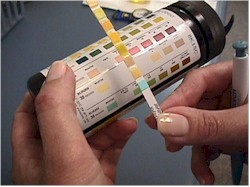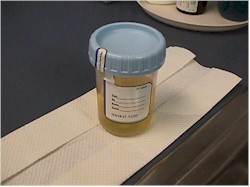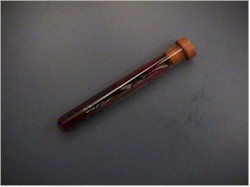
|
Lesson 2: Specimen Collections
Urinalysis is included in a health examination, and as part of the admission process for all inpatients. Simple urine tests, such as for sugar and acetone, are often performed by the nurse in the hospital or by the patient at home. Urine is assessed first for its physical appearance:
a. Color. Freshly voided urine is transparent and light amber in color. The amount and kinds of waste in the urine make it lighter or darker. Blood in the urine colors it; if the amount of blood in the urine is great, the urine will be red. During a flare-up of chronic nephritis, the small number of red blood cells present in the urine give it a smoky appearance.
b. Odor. Freshly voided urine has a characteristic odor. When urine stands, decomposition from bacterial activity gives it an ammonia-like odor. Refrigerate the urine sample if it is not to be examined at once.
2-13. MIDSTREAM URINE SPECIMEN
Midstream (clean-catch) urine collection is the most common method of obtaining urine specimens from adults, particularly men. This method allows a specimen, which is not contaminated from external sources to be obtained without catheterization.
a. Supplies and Equipment.
(1) Sterile specimen cup.
(2) Zephiran, a soap solution, or three antiseptic towelettes.
(3) Three cotton balls (to use with zephiran or soap solution).
(4) Laboratory request form.
b. Procedure.
(1) Instruct the patient to clean the urethral area thoroughly. This will prevent external bacteria from entering the specimen. The female should wipe from front to back to avoid contaminating the vaginal and urethral area from the anal area. She should clean each side with a separate cotton ball or towelette, then use the last one for the urethral area itself. The male should cleanse the penis, using the first cotton ball or towelette for the urethral meatus, the next cotton ball to clean the end of the penis, and the last to cleanse the urethral opening.
(2) Instruct the patient to void a small amount of urine into the toilet to rinse out the urethra, void the midstream urine into the specimen cup, and the last of the stream into the toilet. The midstream urine is considered to be bladder and kidney washings; the portion that the physician wants tested.
(3) Complete the laboratory request form, label the specimen container with patient identifying information, and send to the lab immediately. A delay in examining the specimen may cause a false result when bacterial determinations are to be made.
(4) Wash your hands and instruct the patient to do likewise.
(5) Record that the specimen was collected. Note any difficulties the patient had or if the urine had an abnormal appearance.
A 24-hour urine collection always begins with an empty bladder so that the urine collected is not "left over" from previous hours. This specimen shows the total amounts of wastes the kidneys are eliminating and the amount of each.
a. Supplies and Equipment.
(1) Large, clean bottle with cap or stopper.
(2) Measuring graduate.
(3) Bedpan or urinal.
(4) Refrigerated storage area.
(5) Gloves.
b. Procedure.
(1) Label the bottle with patient identifying information, the date, and time the collection begins and ends.
(2) Instruct the patient to void all urine into a bedpan or urinal. Measure each specimen of urine voided and pour into the refrigerated bottle. Wash your hands before and after each collection. Record each amount on the intake and output (I&O) sheet.
(3) Exactly 24-hours after beginning the collection, ask the patient to void. This will complete the specimen collection.
(4) Send the bottle and laboratory request form to the lab.
Most pregnancy tests are based on the fact that the hormone human chorionic gonadotropin (HCG) is secreted by the chorionic villi of the placenta. This hormone can be detected in small amounts in both the urine and the blood of a pregnant woman by the 15th day of pregnancy. Urine tests are available for home use and offer quick results with 90 percent to 95 percent accuracy.
a. Supplies and Equipment. Only a urine specimen cup is required.
b. Procedure.
(1) Instruct the patient to void the very first urine when she gets up in the morning into the specimen cup.
(2) Label the specimen cup with the patient's identifying information, complete a laboratory request form (Chemistry I, SF 546) requesting an HCG test and send both to the lab.
(3) Only the physician or a registered nurse should tell the patient the results of the test.
|
Blood cultures are done to identify a disease-causing organism, especially in patients who have an elevated temperature for an unknown reason. Drawing blood from HIV positive patients is done in accordance with the hospital or clinic's local policy (see universal precautions).
Supplies and equipment required for a blood culture are
a. Sterile syringe (20 cc) and three needles (usually 20 gauge).
b. Two blood culture bottles (one for anaerobic and one for aerobic specimens).
c. Betadine solution.
d. Sterile cotton balls or gauze pads.
e. Gloves.
f. Tourniquet.
g. Band-aid®.
h. Chux® (to protect the bed)
i. Laboratory request form.
2-18. PROCEDURE FOR BLOOD CULTURES
a. Explain the procedure and the reason for doing the procedure to the patient.
b. Gather all supplies and equipment and bring to the patient's bedside.
c. Assist the patient to a comfortable position. If the patient is uncooperative or disoriented, get someone to help you.
d. Carefully wash your hands.
e. Clean the top of both culture bottles with betadine solution.
f. Put the needle on the syringe.
g. Apply the tourniquet.
h. Put on the gloves and clean the drawing site with betadine solution.
i. Draw at least 10 cc of blood from the patient (5 cc is needed for each bottle).
j. Loosen the tourniquet.
k. Remove the syringe and needle while applying pressure to the venipuncture site with the cotton ball or gauze pad. Have the patient apply pressure to the site.
l. Replace the needle on the syringe with another sterile needle.
m. Inject 5 cc of blood into the anaerobic bottle; do not allow air to enter the bottle.
n. Replace the needle on the syringe with another sterile needle.
o. Inject 5 cc of blood into the aerobic bottle and while the needle is still in the bottle, disconnect it from the syringe so that air enters the aerobic bottle.
p. Gently mix the blood with the solution in both bottles.
q. Label both bottles with patient identifying information and the type of culture hat is, aerobic or anaerobic).
r. Complete laboratory request forms and send the specimens to the laboratory immediately.
s. Place a band-aid over the patient's venipuncture site.
The role you play in collecting and labeling specimens and ensuring their timely delivery to the lab for analysis is a very important one. Carefully follow the steps of each procedure to prevent contaminating the specimen or spreading infection. Always document that the procedure was done and by whom.
|
|||||||||
|
LESSON OBJECTIVES |
|||||||||
|


